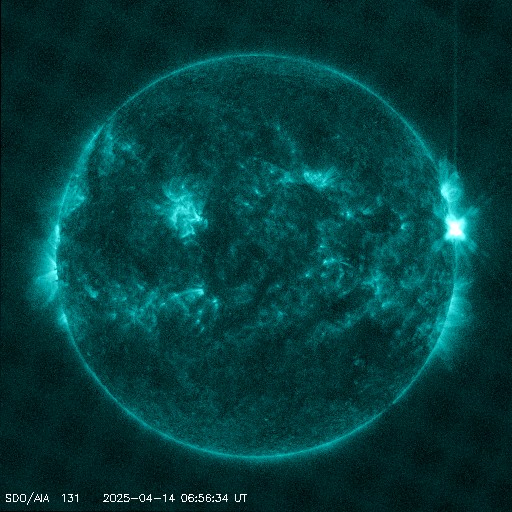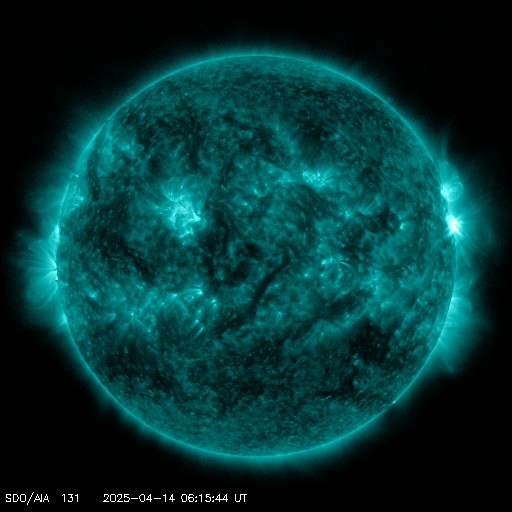Viewing archive of Tuesday, 13 September 2005
Solar activity report
Any mentioned solar flare in this report has a scaling factor applied by the Space Weather Prediction Center (SWPC). Because of the SWPC scaling factor, solar flares are reported as 42% smaller than for the science quality data. The scaling factor has been removed from our archived solar flare data to reflect the true physical units.
Report of Solar-Geophysical Activity 2005 Sep 13 2223 UTCPrepared by the NOAA © SWPC and processed by SpaceWeatherLive.com
Joint USAF/NOAA Report of Solar and Geophysical Activity
SDF Number 256 Issued at 2200Z on 13 Sep 2005IA. Analysis of Solar Active Regions and Activity from 12-2100Z to 13-2100Z
Solar activity was high. Region 808 (S11E04) produced
an M1.3 at 13/1121 UTC and an X1.5/3b at 13/1927 UTC. Strong
centimetic radio bursts accompanied this flare including a 4900 sfu
Tenflare and a 24,000 sfu burst on the 8800 MHz frequency. The X1.5
flare initially began as an impulsive flare; however, X-ray flux
values began rising again resulting in a long duration event with a
second peak above X1 levels. LASCO imagery shows a very bright and
fast full halo CME with this event with a preliminary speed estimate
of 1500 km/s. Region 808 underwent some slow decay over the last 24
hours, but still retains a strong beta-gamma-delta configuration.
IB. Solar Activity Forecast
Solar activity is expected to be
moderate to high. Region 808 has potential for M and X-class
activity.
IIA. Geophysical Activity Summary 12-2100Z to 13-2100Z
The geomagnetic field has been at unsettled to major storm levels.
Storm conditions persisted through much of this period due to
transient flow from the intense CME activity over the past several
days. Conditions returned to predominantly unsettled levels by the
end of the period. Solar wind speed at ACE remains elevated, but
decreased from a high near 800 km/s to approximately 650 km/s by the
end of the period. The greater than 10 MeV proton event that began
on 08 September fell below the 10 pfu threshold today. The greater
than 2 MeV electron flux at geosynchronous orbit reached high levels
today.
IIB. Geophysical Activity Forecast
The geomagnetic field is
expected to be unsettled to minor storm levels on 14 September. On
15 September, major to severe storm periods are possible due to the
expected arrival of the CME associated with today's X1 flare.
Conditions should subside to mostly unsettled to active levels by 16
September, with isolated minor storm periods possible.
III. Event Probabilities 14 Sep to 16 Sep
| Class M | 80% | 75% | 70% |
| Class X | 50% | 40% | 30% |
| Proton | 40% | 40% | 30% |
| PCAF | green | ||
IV. Penticton 10.7 cm Flux
Observed 13 Sep 114 Predicted 14 Sep-16 Sep 115/110/110 90 Day Mean 13 Sep 092
V. Geomagnetic A Indices
Observed Afr/Ap 12 Sep 032/066 Estimated Afr/Ap 13 Sep 025/060 Predicted Afr/Ap 14 Sep-16 Sep 018/025-050/100-015/020
VI. Geomagnetic Activity Probabilities 14 Sep to 16 Sep
| A. Middle Latitudes | |||
|---|---|---|---|
| Active | 30% | 10% | 30% |
| Minor storm | 20% | 20% | 15% |
| Major-severe storm | 10% | 70% | 05% |
| B. High Latitudes | |||
|---|---|---|---|
| Active | 35% | 10% | 30% |
| Minor storm | 20% | 20% | 20% |
| Major-severe storm | 15% | 70% | 10% |
All times in UTC
Current data suggests there is a slight possibility for aurora to appear at the following high latitude regions in the near future
Gillam, MB, Yellowknife, NTLatest news
Latest forum messages
2025/04/12-13 Filament CMEs 2025/04/16 G2 Watch 46Ask your obscure/"stupid" space weather questions. 351Incoming & Unnumbered Active Regions 1708Filaments and prominences 61AR 4055 99
More topicsSupport SpaceWeatherLive.com!
A lot of people come to SpaceWeatherLive to follow the Sun's activity or if there is aurora to be seen, but with more traffic comes higher server costs. Consider a donation if you enjoy SpaceWeatherLive so we can keep the website online!

Latest alerts
Monday, 14 April 2025
23:15 UTC - Geomagnetic activity
Active geomagnetic conditions (Kp4) Threshold Reached: 23:01 UTC
07:09 UTC - Solar flare
Moderate M4.28 flare from sunspot region 4055
06:48 UTC - Radio Blackout
Minor R1 radio blackout in progress (≥M1 - current: M1.53)
06:24 UTC - Solar flare
Moderate M1.49 flare from sunspot region 4055
06:06 UTC - Radio Blackout
Minor R1 radio blackout in progress (≥M1 - current: M1.16)
Space weather facts
| Last X-flare | 2025/03/28 | X1.1 |
| Last M-flare | 2025/04/14 | M4.2 |
| Last geomagnetic storm | 2025/04/06 | Kp5 (G1) |
| Spotless days | |
|---|---|
| Last spotless day | 2022/06/08 |
| Monthly mean Sunspot Number | |
|---|---|
| March 2025 | 134.2 -20.4 |
| April 2025 | 128.8 -5.4 |
| Last 30 days | 129.1 -15.1 |





